

Most ebook files are in PDF format, so you can easily read them using various software such as Foxit Reader or directly on the Google Chrome browser.
Some ebook files are released by publishers in other formats such as .awz, .mobi, .epub, .fb2, etc. You may need to install specific software to read these formats on mobile/PC, such as Calibre.
Please read the tutorial at this link: https://ebookbell.com/faq
We offer FREE conversion to the popular formats you request; however, this may take some time. Therefore, right after payment, please email us, and we will try to provide the service as quickly as possible.
For some exceptional file formats or broken links (if any), please refrain from opening any disputes. Instead, email us first, and we will try to assist within a maximum of 6 hours.
EbookBell Team

5.0
100 reviewsUntil now, there has been a lack of a complete knowledge base to fully comprehend Low power (LP) design and power aware (PA) verification techniques and methodologies and deploy them all together in a real design verification and implementation project. This book is a first approach to establishing a comprehensive PA knowledge base.
LP design, PA verification, and Unified Power Format (UPF) or IEEE-1801 power format standards are no longer special features. These technologies and methodologies are now part of industry-standard design, verification, and implementation flows (DVIF). Almost every chip design today incorporates some kind of low power technique either through power management on chip, by dividing the design into different voltage areas and controlling the voltages, through PA dynamic and PA static verification, or their combination.
The entire LP design and PA verification process involves thousands of techniques, tools, and methodologies, employed from the r
egister transfer level (RTL) of design abstraction down to the synthesis or place-and-route levels of physical design. These techniques, tools, and methodologies are evolving everyday through the progression of design-verification complexity and more intelligent ways of handling that complexity by engineers, researchers, and corporate engineering policy makers.